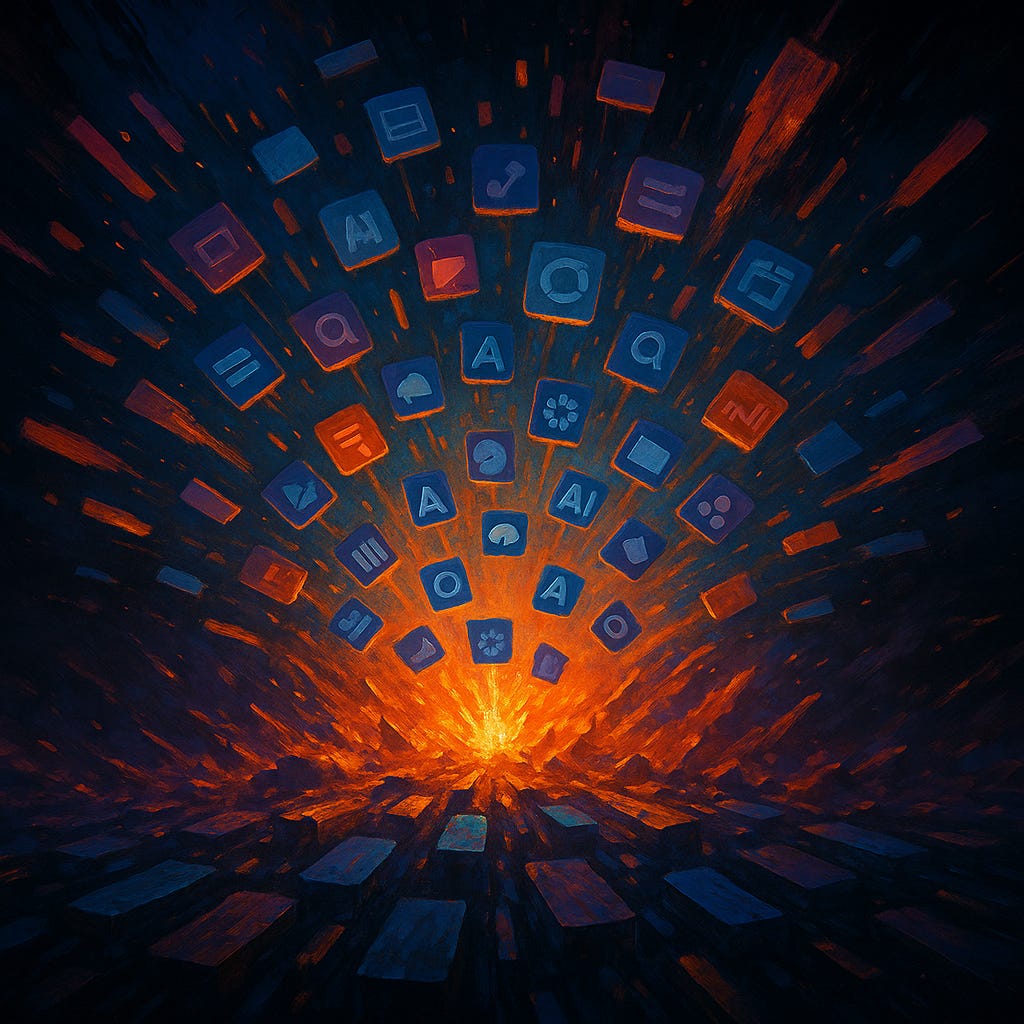Software’s Cambrian explosion: How AI might flood the software world
For decades, the music and entertainment industries were shaped by scarcity. Recording an album or producing a show required capital, studio access, and a distribution network—barriers that kept creative output limited and controlled by a few large players. The internet erased those barriers. Platforms like YouTube, Spotify, and TikTok made creation and distribution nearly free, flooding the world with new artists and independent producers. The result was a structural shift: creation became abundant, attention became scarce, and the balance of power moved from the producers to the platforms that organized their work.
Something similar might happen to software.
AI is driving the cost of making software toward zero. A solo founder can summon an application from a prompt, iterate it in hours, and ship globally without touching a line of code.
“Starting a business may become so cheap and hassle-free that anyone will be able to become an entrepreneur much as anyone can become a YouTuber,” The Economist - August 2025.
Code, in other words, is about to go the way of music: infinite supply, negligible marginal cost, and a flood of new creators. This is software’s Cambrian explosion—a phase of evolutionary overproduction where every niche, every problem, every fleeting idea can spawn its own micro-app.
To see what that might look like, we need to rewind to the internet’s first great abundance experiment. Before YouTube, TikTok, and Spotify, the entertainment industry ran on scarcity. Access to distribution—airwaves, stores, or cable channels—was limited. Record labels and TV networks were the gatekeepers, rationing what reached the public. Then came the platforms.
A musician no longer needed a label; a teenager with a phone could find a global audience overnight. By 2024, nearly 99,000 songs were uploaded to streaming services every day, amounting to 202 million tracks online by year’s end. 12 million artists uploaded music to Spotify in 2024, up from 10 million the year before. The scale dwarfs anything the old industry could have imagined.
But abundance has gravity. Eighty-six percent of Spotify tracks attracted fewer than 1,000 streams, effectively vanishing into the long tail. “Streaming has allowed millions to easily share their music globally,” Spotify noted, “but the sheer volume of uploaders means the fraction who find success appears smaller over time.” The bottleneck shifted: creation was easy, discovery was hard. Algorithms—once invisible curators—became the new tastemakers.
Legacy players didn’t vanish; they mutated. Labels and studios survived by cutting deals with platforms, licensing catalogs, and feeding the algorithm with steady output. But they ceded the high ground. Power moved from those who produced content to those who distributed and curated it. Spotify, YouTube, and TikTok became the new gatekeepers, filtering the flood through recommendation engines and playlists.
I believe that software is about to undergo that same transformation.
As AI makes it trivial to create apps, websites, and agents, the scarcity in software will no longer be code—it will be distribution, data, and trust. When marginal cost approaches zero, markets explode outward. Problems once too small to attract venture dollars—say, a dashboard for mushroom farmers or an AI concierge for wedding planning—suddenly become viable.
AI will allow anyone with an idea and curiosity to build something that works. But that flood has consequences. Hundreds of near-identical AI-generated tools will appear overnight, many indistinguishable in function or quality. Just as streaming turned the music economy into a power law—where a tiny fraction of artists capture the majority of plays—the software market could polarize between a few aggregators and millions of niche creators barely scraping visibility. The next Spotify or YouTube for software won’t be a tool that helps people make apps—it’ll be the system that helps people find them.
In Ben Thompson’s Aggregation Theory, the internet shifted power from producers to the platforms that organize them—a pattern now replaying at planetary scale. The winners of the software Cambrian explosion won’t be the thousands of AI developers churning out clones of each other’s tools, but the ecosystems that aggregate, distribute, and power them. On one level, these aggregators will take the form of app stores, plugin marketplaces, and trust layers—Spotify playlists for code, recommendation systems for tools.
However, underneath that creative surface lies a deeper concentration of power. The abundance of software rests on a foundation of extraordinary consolidation: a handful of companies provide the hardware, compute, and intelligence that make the entire explosion possible. NVIDIA is the pick-and-shovel vendor of this gold rush, minting revenue on every GPU that fuels the boom. Above it sit the GenAI model providers—OpenAI, Anthropic, Mistral—each competing to become the default intelligence layer for millions of new applications. Beneath it all hum the hyperscalers—AWS, Azure, and Google Cloud—whose data centers, energy contracts, and fiber networks form the physical substrate of abundance. Together, these layers make up the new industrial stack of software: decentralized creation running on centralized infrastructure. The creative layer fragments, but the substrate concentrates.
The tension between decentralization and concentration defines this new era. Abundance empowers individuals, but dependence on shared infrastructure ensures that power and profit remain concentrated among a few dominant players. For developers and entrepreneurs, this dual reality will demand realism: access and opportunity have never been greater, but so too is reliance on the invisible scaffolding of compute, models, and networks owned by others.
The Cambrian explosion will produce extraordinary diversity, but the ecosystem that sustains it will remain highly managed, capital-intensive, and vertically integrated. And immensely profitable.



